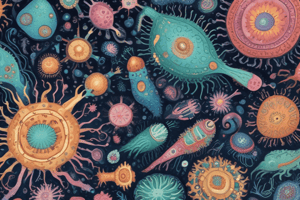Podcast
Questions and Answers
How do intestinal infections occur?
How do intestinal infections occur?
What is the mode of transmission of intestinal infections?
What is the mode of transmission of intestinal infections?
What is responsible for producing lesions in amoebiasis?
What is responsible for producing lesions in amoebiasis?
What is the source of intestinal infections?
What is the source of intestinal infections?
Signup and view all the answers
What is the result of invasion of blood vessels in amoebiasis?
What is the result of invasion of blood vessels in amoebiasis?
Signup and view all the answers
How can intestinal infections be spread?
How can intestinal infections be spread?
Signup and view all the answers
What is the primary source of intestinal infections?
What is the primary source of intestinal infections?
Signup and view all the answers
What type of lesions are produced by trophozoites in amoebiasis?
What type of lesions are produced by trophozoites in amoebiasis?
Signup and view all the answers
What happens when trophozoites invade blood vessels in amoebiasis?
What happens when trophozoites invade blood vessels in amoebiasis?
Signup and view all the answers
What is the outcome of trophozoite invasion in amoebiasis?
What is the outcome of trophozoite invasion in amoebiasis?
Signup and view all the answers
What happens to the effect of the parasite on the host over time?
What happens to the effect of the parasite on the host over time?
Signup and view all the answers
What happens to the host's tolerance to the parasite?
What happens to the host's tolerance to the parasite?
Signup and view all the answers
What happens to the trophozoites in the lumen of the bowel?
What happens to the trophozoites in the lumen of the bowel?
Signup and view all the answers
What is the outcome for the parasite's life cycle in the trophozoite phase?
What is the outcome for the parasite's life cycle in the trophozoite phase?
Signup and view all the answers
Where do the trophozoites come from before entering the lumen of the bowel?
Where do the trophozoites come from before entering the lumen of the bowel?
Signup and view all the answers
What is the primary function of the cyst stage?
What is the primary function of the cyst stage?
Signup and view all the answers
How do trophozoites reproduce?
How do trophozoites reproduce?
Signup and view all the answers
What is the characteristic of the mature cyst?
What is the characteristic of the mature cyst?
Signup and view all the answers
What is the characteristic of the nucleus in terms of chromatin arrangement?
What is the characteristic of the nucleus in terms of chromatin arrangement?
Signup and view all the answers
What is the location of the karyosome in the nucleus?
What is the location of the karyosome in the nucleus?
Signup and view all the answers
What is the outcome of the development of numerous trophozoites within the mature cyst?
What is the outcome of the development of numerous trophozoites within the mature cyst?
Signup and view all the answers
What is the primary stage of infection?
What is the primary stage of infection?
Signup and view all the answers
What is the characteristic of motility in terms of direction?
What is the characteristic of motility in terms of direction?
Signup and view all the answers
What is the mechanism of motility?
What is the mechanism of motility?
Signup and view all the answers
What is the characteristic of motility in terms of speed?
What is the characteristic of motility in terms of speed?
Signup and view all the answers
Study Notes
Life Cycle of Amoeba
- The cyst stage is quiescent, resistant, and infective.
Reproduction
- Amoebas reproduce through binary fission, where the trophozoite splits.
- Alternatively, numerous trophozoites develop within a mature multinucleated cyst.
Characteristics
- Motility is rapid, progressive, and unidirectional, facilitated by pseudopods.
- The nucleus is characterized by evenly arranged chromatin on the nuclear membrane and a small, compact, centrally located karyosome.
Infection and Transmission
- Intestinal infections occur through the ingestion of a mature quadric nucleate infective cyst.
- Contaminated food, drink, and hand-to-mouth contact can transmit the infection.
Pathogenesis
- Trophozoites produce lesions in amoebiasis.
- Invasion of blood vessels leads to secondary extra-intestinal lesions.
Host-Parasite Interaction
- The parasite's effect on the host decreases over time, while host tolerance increases, making it difficult for the parasite to continue its life cycle in the trophozoite phase.
Cyst Formation
- Some trophozoites from tissues enter the bowel lumen and transform into pre-cyst forms.
Studying That Suits You
Use AI to generate personalized quizzes and flashcards to suit your learning preferences.
Description
This quiz covers the quiescent, resistant, and infective stages of cyst development, including their reproduction through binary fission and the development of numerous trophozoites within the mature multinucleated cyst.




